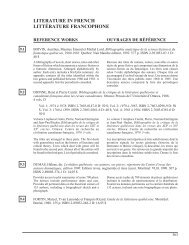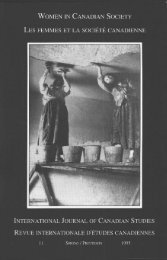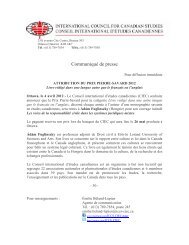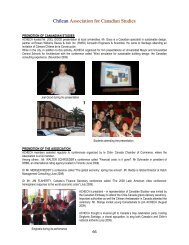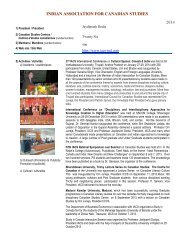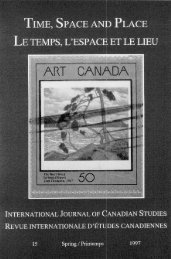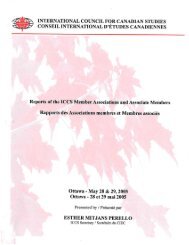Arts and Literature in Canada:Views from Abroad, Les arts et la ...
Arts and Literature in Canada:Views from Abroad, Les arts et la ...
Arts and Literature in Canada:Views from Abroad, Les arts et la ...
- No tags were found...
You also want an ePaper? Increase the reach of your titles
YUMPU automatically turns print PDFs into web optimized ePapers that Google loves.
Immigrant Voices <strong>from</strong> Indiawhich is m<strong>et</strong>afictional <strong>in</strong> character, the author-narrator’s parents are seen toexcitedly pore over “The Tales <strong>from</strong> Firozsha Baag” that their son has senthome <strong>from</strong> <strong>Canada</strong>. The father likes the <strong>la</strong>st story the best because it is about<strong>Canada</strong>, <strong>and</strong> he muses: “if he cont<strong>in</strong>ues to write about such th<strong>in</strong>gs he willbecome popu<strong>la</strong>r because I am sure they are <strong>in</strong>terested there <strong>in</strong> read<strong>in</strong>g aboutlife through the eyes of an immigrant, it provides a different viewpo<strong>in</strong>t...”(248). Despite these <strong>in</strong>timations, however, Mistry’s work cont<strong>in</strong>ues to explor<strong>et</strong>he old world; he has even affirmed at a public forum that the current novel heis work<strong>in</strong>g on cont<strong>in</strong>ues to have Bombay as the locale. 18 Undoubtedly,Vassanji’s second novel, No New L<strong>and</strong>, 19 <strong>and</strong> Nazneen Sadiq’s first novel, IceBangles, 20 are s<strong>et</strong> <strong>in</strong> <strong>Canada</strong> though they cont<strong>in</strong>ue to explore the lives of theirown communities. By <strong>and</strong> <strong>la</strong>rge, however, s<strong>in</strong>ce the novel as a genre deals witha complex n<strong>et</strong>work of re<strong>la</strong>tionships <strong>and</strong> has a <strong>la</strong>rge social frame, the firstgeneration,immigrant novelist might f<strong>in</strong>d it problematic to reach out to thatk<strong>in</strong>d of experience <strong>in</strong> the re<strong>la</strong>tively “foreign” homel<strong>and</strong> of <strong>Canada</strong>. It is easierfor him to tread homeground, even when, by do<strong>in</strong>g so, he can tread that muchmore firmly on alien soil. The long gestation period might also be ow<strong>in</strong>g to thefact that even ma<strong>in</strong>stream Canadian writ<strong>in</strong>g is re<strong>la</strong>tively young. Ghosh (albeit<strong>in</strong> the British immigrant context) po<strong>in</strong>ts to y<strong>et</strong> another reason for the immigrantwriter’s emphasis on <strong>and</strong> preoccupation with his l<strong>and</strong> of his orig<strong>in</strong> rather thanof adoption. “The voice of the immigrant” Ghosh writes, “is very easilymarg<strong>in</strong>alised with<strong>in</strong> the culture of the new ‘mother’ country; be<strong>in</strong>gimperfectly British, the immigrant is simply excluded as a p<strong>la</strong>yer <strong>in</strong> the motherculture. It is no co<strong>in</strong>cidence, therefore, that so many diasporic Indianwriters...so often choose to write about India or about Indian communitiesabroad” (77).Hence, it is through the more manipu<strong>la</strong>tive genre of po<strong>et</strong>ry that immigrantwriters can speak more directly of actual Canadian existence, of the historicalpresent, of the experience of alienation <strong>and</strong> of racism. Concomitantly, thepo<strong>et</strong>ry of women immigrants conveys still more <strong>in</strong>tensely what it means to beon the periphery. 21 In this context, Suniti Namjoshi’s re<strong>in</strong>terpr<strong>et</strong>ation of thePhilomel myth embodies the desperate need of a woman of colour to f<strong>in</strong>d herown “voice”.She had her tongue ripped out, <strong>and</strong> then she sang down through thecenturies. So that it seems only fitt<strong>in</strong>g that the art she practises shouldbe art for art’s sake <strong>and</strong> no never spelt out, no — never reduced tomere message — that would appal. (Fem<strong>in</strong>ist Fables 102) 22In this verse, a cultural symbol <strong>and</strong>, moreover, a western myth, servessubversive ends. Not only does it protest aga<strong>in</strong>st the violence done to womenthrough the convert reference to Philomel’s rape, it suggests the violence don<strong>et</strong>o women’s writ<strong>in</strong>g which perforce had to possess the swe<strong>et</strong> serenity of thenight<strong>in</strong>gale’s song. The voice of protest, necessitated by gender <strong>and</strong>, <strong>in</strong> thiscase, by racial marg<strong>in</strong>alization, would sound too raucous to ears attuned to theaesth<strong>et</strong>ic pleasures of po<strong>et</strong>ry.91



